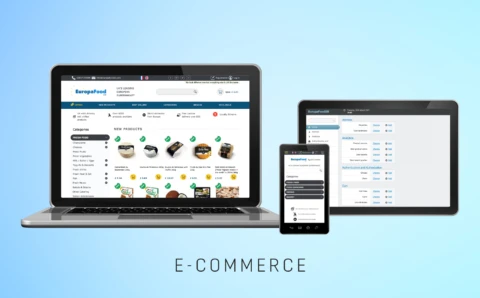
A payment gateway is a time-tested strategy for implementing highly protected and handy online transactions. This solution plays the role of an intermediary between commercials and financial institutions. It provides a guarantee that sensitive payment details are transmitted safely, facilitating enhanced consumer trust and allowing businesses to cover an extended user base all over the world. As per a data model, the market size of payment gateways in Europe is expected to experience a substantial growth of approximately 300 percent from 2023 to 2030, according to Statista. As businesses keep integrating a payment gateway into their digital ecosystems, it’s essential to be aware of the related costs.
A payment gateway integration cost incorporates a range of core elements, which we’ll cover in this article. Let’s overview the vital aspects that set the base for the estimation of payment gateway implementation costs, defining the importance of thorough guidance for successful and cost-effective integration.
Table of Contents:
Factors Influencing Payment Gateway Integration Costs
Let’s start by outlining the core aspects that form the cost of payment gateway integration services.
Transaction Volume and Type
Typically, payment gateways ensure tiered pricing structures. Here, higher transaction volumes may result in a lower per-transaction fee. Thus, businesses processing vast loads of transactions benefit from economies of scale, experiencing reduced costs per transaction. Comprehension of the pricing tiers and negotiation of volume-based discounts with the selected payment gateway can lead to significant cost savings over time.
In addition, diverse payment gateway integration providers may have distinct pricing models for various transaction types. To illustrate, it may be credit card transactions, digital wallet payments, or international financial transfers. Each transaction type may have particular processing fees, and businesses should consider these variations when estimating integration costs.
Payment Gateway Providers
It’s vital to select the relevant payment gateway provider, as each offers its outstanding set of features, pricing, and integration necessities. Put it in practice: with PayPal, you get an intuitive setup yet may incur comparatively higher transaction fees. Stripe, in contrast, equips you with extended customization opportunities but may require more technical expertise. Other payment vendors, Authorize.Net and Square, possess their unique benefits and considerations. An in-depth comparison of these providers is inalienable in terms of account transaction fees, security features, and the entire payment gateway integration cost.
Consequently, the chosen payment gateway provider significantly impacts integration costs. Some providers offer robust developer resources, APIs, and documentation, optimizing the integration process and potentially reducing development time and the necessary costs. On the other hand, certain vendors may require stricter compliance requirements or advanced security techniques, resulting in more extensive development efforts and potentially incurring higher integration costs. You should carefully think over the chosen provider’s offerings, and alignment with the business’s specific needs is crucial to optimizing integration costs and ensuring a seamless payment processing experience.
Depending on the vendor, payment gateway integration for a website costs differently. Let’s compare various API providers in the table below.
| Features | PayPal | Stripe | Authorize.Net | Square |
| Transaction fees | Varies by country; roughly around 2.9% + $0.30 per transaction | Varies by country; approximately 2.9% + $0.30 per transaction | 2.9% + $0.30 per transaction (may vary) | 2.6% + $0.10 per transaction for online sales |
| Monthly fees | None for basic; fees for advanced features | None | Varies based on plan ($25 – $199) | None |
| Supported countries | Extended international coverage | Available in 46 countries with more to come | Primarily U.S. and a few international countries | U.S., Canada, Japan, Australia, and the UK |
| Ease of Integration | User-friendly; well-documented APIs | Developer-friendly; comprehensive documentation | Well-documented with developer resources | Straightforward integration |
| Customization | Moderate customization opportunities | Highly customizable | Offers customization options | Limited customization compared to others |
| Security level | Solid security measures | Strong emphasis on security; PCI compliant | Emphasizes security and PCI compliance | Secure payment processing |
| International support | Extensive | Available, but not as widespread as PayPal | Limited; primarily focused on the U.S. | Limited to supported countries |
| Additional services | PayPal Working Capital, PayPal Credit | Stripe Sigma (data analytics), Stripe Radar (fraud prevention) | Advanced Fraud Detection Suite available | Square Capital for business financing |
For a more accurate estimation of your payment gateway integration costs, using a IT cost calculator designed specifically for software development expenses can provide valuable insights and help plan your budget effectively.
Hidden Costs and Considerations
Here are the aspects within the cost for payment gateway integration you might overlook at first glance, but they may also require additional finances.
Maintenance Fees
While initial integration costs are a primary aspect to take care of, businesses must keep in mind ongoing maintenance fees associated with payment gateways. These comprise charges for updates, security patches, and continued support. Such fees vary among providers and may be influenced by the complexity of the integration.
Aside from visible elements forming the cost for payment gateway integration, businesses should also focus on potential hidden costs for customer support beyond a specific range, some extra customization requests, or fees for exceeding transaction limits. Investigation of the provider’s terms and conditions thoroughly can help you uncover these hidden expenses so businesses can manage costs properly.
Security and Compliance
Implementing and updating security protocols, encryption technologies, and fraud prevention measures is an essential contribution to ongoing costs. Examinations within security are crucial not only to protect sensitive customer information but also to save the business from potential penalties, law violations, and consequent reputational damage.
Providing compliance with industry standards and regulations, such as PCI DSS (Payment Card Industry Data Security Standard), may increase the payment gateway integration cost due to compliance-related expenses. You should allocate resources for regular audits, assessments, and adjustments to meet evolving compliance requirements. Thus, adherence to industry standards is a vital aspect of the overall cost considerations in payment gateway integration.
Stay Ahead of the Curve with Payment Trends
Discover the latest innovations shaping the future of online payments and elevate your business.
Challenges
What challenges can be faced when it comes to payment gateway integration? Let’s discuss.
Technical Complexity
Connecting a payment gateway to the website or application always requires technical expertise, and working with APIs can be a process. API integration comprises the seamless interaction between the payment gateway and the business’s software, necessitating robust coding and programming skills. Developers must navigate authentication, data transmission, and error-handling intricacies to ensure a smooth and secure payment processing experience for users.
In addition, compatibility with existing systems and technologies can ensure certain complexities. Businesses may deal with compatibility issues when integrating a payment gateway, especially with legacy systems or diverse technology stacks. Addressing them requires profound planning, testing, and potential system updates to achieve a cohesive and efficient payment processing environment.
Security Concerns
Robust security measures are indispensable to protect sensitive customer data during transactions. This involves employing encryption protocols, secure transmission methods, and safe storage practices. You should put data security first and consider it a vital component of payment gateway integration price. Therefore, you can build trust with customers and safeguard against potential breaches.
Adhering to the PCI DSS is a challenge and a great solution at the same time. Compliance with this regulation is necessary for handling payment card data securely. This necessitates regular assessments, implementing security policies, and maintaining a secure network infrastructure. As was mentioned, non-compliance can lead to severe consequences, such as financial losses and damage to the company’s reputation.
Regulatory Compliance
Payment gateways must adhere to local and international laws, like data protection regulations and consumer rights, which impacts a payment gateway development cost as well. Frequently implemented updates and adjustments to compliance practices are necessary to navigate the dynamic regulatory landscape and mitigate legal risks.
Ensuring compliance with international guidelines is critical, especially for businesses operating in multiple regions. Global compliance refers to adherence to diverse regulatory frameworks, data privacy laws, and financial regulations across regions and countries. Balancing operations with international standards is a path for maintaining a trustworthy and legally operating payment gateway system on a global scale.
User Experience
Users should be able to complete transactions seamlessly without process disruptions. A well-integrated payment gateway enhances user dedication and satisfaction, facilitating a positive overall roadmap during the online purchasing procedure.
Furthermore, with the requirement of mobile transactions, optimizing the payment gateway for mobile devices becomes a modern must-have. A seamless and responsive design enhances the mobile user experience, facilitating convenient and secure payments on smartphones and tablets.
Transaction Errors and Reconciliation
The introduction of robust error-handling mechanisms is core to handling transaction failures and minimizing customer impact. Robust error handling ensures that issues such as declined transactions or system errors are addressed rapidly, providing users with clear and helpful information to resolve the problem. A well-designed error-handling system contributes to a positive user experience and helps prevent frustration during the payment process.
Managing and reconciling transactions, especially in high-volume cases, can become more challenging. Reconciliation covers comparing financial records, detecting discrepancies, and ensuring accuracy in accounting. In high-volume situations, the complexity increases, necessitating efficient tools and processes for reconciliation. Businesses must implement comprehensive reconciliation practices to maintain financial integrity, identifying and addressing any discrepancies that may arise.
Performance and Scalability
As businesses continue to expand, the demand for the payment gateway also increases. Scalability involves designing the system architecture to handle higher transaction volumes without compromising performance. This preparation ensures the payment gateway can seamlessly accommodate growth, preventing issues such as slowdowns or system failures during peak times.
Optimizing the payment process for speed and efficiency is essential for providing a seamless user experience. This implies streamlining code, minimizing latency, and optimizing database queries to ensure swift transaction processing. A streamlined payment gateway contributes to faster transaction completion, reducing the likelihood of user abandonment and enhancing overall customer satisfaction. Regular performance assessments and optimizations are vital to maintaining a high-performing payment system.
Costs and Fees
Transparent pricing allows businesses to make relevant decisions based on their budget and transaction volume. This implies being aware of transaction fees, monthly subscription costs, and any additional charges for specific features or services. Clear communication from the payment gateway provider helps businesses plan effectively and avoid unexpected financial outgoings.
An exemplary hidden payment gateway cost for a website can incorporate charges for exceeding transaction limits, additional customer support beyond a certain threshold, or fees for specific customization requests. Thoroughly reviewing the terms and conditions of the payment gateway provider and defining clarification on potential hidden fees helps businesses anticipate and manage their overall costs more effectively.
Customer Support
Businesses may face technical issues or require assistance with integration, and having a responsive support team can significantly minimize downtime and ensure a smooth payment integration experience. Timely resolution of technical challenges provides undisrupted and smooth payment gateway service, as well as business credibility.
Companies should make sure that the payment process is seamless and transparent. Clear and accessible information about the payment process helps users navigate transactions confidently, reducing the possibility of errors or confusion. Providing educational resources, FAQs, and customer support channels enhances user comprehension and provides a positive perception of the payment gateway. Internally, well-informed staff can troubleshoot user queries effectively, contributing to a more efficient and user-friendly payment experience.
Testing and Quality Assurance
Conducting comprehensive testing is essential to identify and rectify any bugs or issues before the payment gateway is integrated. Testing should cover various cases, for instance, successful transactions, declined transactions, error handling, and security checks. Thorough testing helps companies ensure that the payment system functions as intended, providing a reliable and secure experience for users.
Besides, compatibility with different browsers, devices, and operating systems is a critical aspect of quality assurance. Compatibility testing helps you identify and address any issues related to the user interface, functionality, or performance on various platforms. By testing across a range of environments, companies can deliver a consistent and seamless payment experience to users, regardless of the devices or browsers they run software on. This approach minimizes the risk of technical issues and enhances the overall reliability of the payment gateway.
Payment Method Diversity
Adapting to the diverse preferences of customers refers to supporting a diversity of payment options. A comprehensive payment gateway should accommodate credit and debit cards, digital wallets, bank transfers, and other popular payment methods. Offering a range of choices enhances user convenience and expands the potential customer base, catering to different preferences and needs.
Addressing the challenges associated with accepting payments in different currencies and through various methods is crucial for businesses operating globally. A practical payment gateway should facilitate seamless international transactions, accommodating local payment methods and currency conversions. Adherence to international standards and regulations ensures a smooth cross-border payment experience, facilitating a broader reach and improved customer satisfaction.
Seamless Payment Gateway Integration
Simplify your payment processing and enhance customer experience with our expert integration services.
Tips for Cost-Effective Integration
Implementing the following tips helps achieve a cost-effective payment gateway integration, ensuring that your chosen solution aligns with the unique demands and future growth of your business.
Create Negotiation Strategies
When reaching out to payment gateway providers, essentially negotiate terms that align with your business needs. Discuss volume-based discounts for transaction fees and explore opportunities for reduced monthly costs. Stay precise about your transaction volume projections and use that information as leverage for better pricing.
What’s more, research and contact several payment gateway providers to leverage competition for better rates. Providers may strive to match or beat competitors’ offers to win the cooperation with your business. Gathering proposals from different providers facilitates you with valuable negotiation insights, ensuring you select the most cost-effective deal for your specific requirements.
Conduct Scalability Planning:
Don’t hesitate to factor in scalability when estimating integration costs. Choose a payment gateway that can seamlessly scale with your business, avoiding significant reintegration expenses as you grow. Understand the provider’s pricing structure for increased transaction volumes and negotiate terms that support scalability without substantial cost spikes.
Prioritize scalability in your integration plan. Select a payment gateway that offers tiered pricing or volume-based discounts, allowing your business to scale without incurring exorbitant fees. Regularly review and adjust your payment processing infrastructure to align with growth projections, ensuring a cost-effective and scalable solution.
Select the Right Payment Gateway for Your Business
Find a balance between cost and value when selecting a payment gateway. While cost is the integral element, consider the additional features, security measures, and support each provider offers. The other features may prove to be a slightly higher upfront cost if the chosen gateway provides superior functionality, reliability, and customer support.
Understand the unique needs of your business before selecting a payment gateway. Consider factors such as transaction volume, international transactions, and desired features. Tailor your choice to align with specific business requirements, avoiding unnecessary expenses for excessive features for your case.
Look beyond the payment gateway development cost and evaluate the overall value provided by the payment gateway. Consider factors that facilitate security, reliability, and performance quality as well. A well-rounded payment gateway may offer long-term benefits that justify a slightly higher initial cost.
Properly executing payment gateway integration requires strategic decision-making. Hidden costs, technical challenges, and user experience form the integration process and expenses for your business case. To make a well-thought-out choice, research payment diversity, delivered services, and features. A profound approach ensures a robust and efficient payment system, transforming integration into a strategic investment for sustained success.

EuropaFoodXB
EuropaFoodXB’s new online store, developed by PLANEKS team, offers a smooth shopping experience, while the CRM system boosts staff productivity.

Restaurant Management
Streamlined operations with a cloud system, centralizing point of sales, labo & inventory data into one dashboard, boosting restaurant profits.

